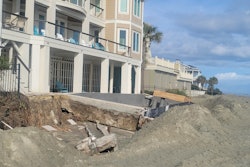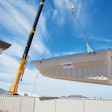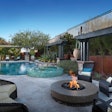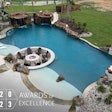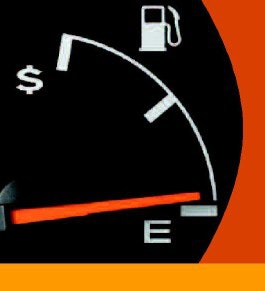
The numbers just keep going higher and higher. Can it really cost this much to fill my gas tank? Imagine how you'd feel filling two tanks, holding between them 200 to 300 gallons. At nearly $3.00 per gallon, that comes out to $600 to $900. Welcome to the world of long-distance trucking in our oil-hungry age. Everyone feels the pain at the pump, and the evening news is full of reports on how rising fuel prices have affected industries across the board. Since so many products in the pool industry are petroleum-based and rely on long-distance transport, that pain is bound to be found here, too. AQUA checked in with the fiberglass industry recently to see how that sector is handling soaring energy expenses in both the distribution and manufacturing of the shells.
Shipping The Shell
As of June 26, 2006, the average price of diesel fuel was $2.86 per gallon, according to Tom Howells, president of the Wisconsin Motor Carriers Association. The same week in 2005, that price was $2.23. That $0.67 increase per gallon seems like a lot, especially when you start doing some math. "One of the benchmarks we always use for an over-the-road truck is that an average truck buys about 20,000 gallons of fuel per year," says Howells. "Based on 6 miles per gallon, if you're getting 20,000 gallons of fuel, multiply it by the current price. Right now, the price of diesel is real close to $3.00 per gallon, so the math comes out to $60,000 per year just for fuel for one truck."
Fiberglass companies, just like other segments of the industry, are forced to deal with rising distribution costs on a daily basis, and have been feeling the pain Howells describes for some time now. Most companies distribute their product with a combination of contracted truck drivers, called owner-operators, who pay for their own fuel, or a small fleet of their own. "What happens is, the large trucking companies, they have a pretty sophisticated system built into place called fuel surcharges, which means that as the price of fuel goes up, their contract with their shippers automatically goes up as well," says Howells. "The guys who really get killed are the owner-operators or small fleets that aren't as sophisticated, and probably some of the people that you're talking about. A pool company might have a small fleet of trucks, or they may be hauling their own products and not have a fuel surcharge, so yeah, it's a big deal."
Owner-operators have been forced to pass on their increased costs to the pool companies they haul for. "They are starting to talk to us about going up 10 percent on their freight rates, purely as a result of the fuel prices," says Ashley Gill, CEO of Leisure Pools USA. Fiberglass companies are using a variety of tactics to deal with these distribution costs, from shipping pools in zones or limiting areas of distribution, to utilizing manufacturing plants around the country, to redesigning the pools themselves.
"Realistically, costs have gone up 20 percent since the beginning of the year, and we look at that from the standpoint of fuel, insurance and road expenses," says Curt Prystupa, president of Sun Fiberglass. "With our product we also use chase cars and if it's over 12 feet wide, we have to use a pilot car. If the load exceeds 14 feet wide, you need two pilot cars. Even pilot cars have gone up relative to the fuel increases. So we try to ask our dealers to order their pools as soon as they get their orders from their customers, and we're trying to put those orders together in zones. We're sending a truck to a zone, and in the old days we may have had one or two pools on there going to one specific destination. Now what we do is we'll put on four or five or six units and send them into that same zone."
Steve Tweedy, owner of Aqua Technics U.S.A., owns the distribution rights for that company's pools, which are manufactured in Western Australia. His company has scaled back distribution as a whole in the United States to address fuel costs. "For instance, to service the Midwest and the Northeast, we would've had to take it into Houston," says Tweedy. "It's no longer profitable for me and I can't stay price competitive with my domestic competition, if you will. I can't really ship a pool to any dealer that is, say, 300 to 400 miles from a port. It just becomes cost ineffective. Road transportation costs, when we first started, were probably anywhere from $1.00 to $2.00 a mile on the most expensive side. Now it's $5.50 a mile."
Some larger manufacturers, like Hawaiian & Aloha Fiberglass Pools, have been able to utilize facilities located throughout the country to offset transportation costs. "We opened a factory in Tennessee about a year and a half ago, but we had been in the process long before its opening," says Michelle Stewart, national sales and marketing director. "And we have another one in Georgia, and that too has just recently come on-line, and although I wish I could say that it was in response to the fuel charges, we started long ago, getting those factories built. It is definitely going to help exponentially in reducing our fuel costs and being in close proximity to our more predominant marketplaces." Since the two new factories opened, joining facilities in Texas and Southern California, the company has employed more short-haul drivers, according to Stewart. "And that's exactly what it was intended for," says Stewart. "It's not a heavy commodity, but it is one that, when you're charging by an oversize load rate — which is higher than your standard truck driver rate — if you're driving 1,500 miles as opposed to 300 to 400 miles, it makes a big difference to the pool builder and, as a result, to the end consumer."
Several companies, including Leisure Pools USA, have employed another solution to the problem — stacking their pools. "With fiberglass pools, the second biggest cost, other than the shell itself, is normally transport and freight, because you're transporting this very large piece of fiberglass around the country," says Gill. The company redesigned its entire pool range in direct response to transportation costs and issues, according to Gill. "So Leisure Pools, going back about eight years in Australia, redesigned its whole pool range. It was all computer designed so that all the pools achieved stackability, which means we can put pretty much all of our range on a single truck load." The U.S. arm of the company, based in San Antonio, Texas, has only four pool designs, built in three or four different sizes, which allows all the models to fit together on the truck like a jigsaw puzzle. "We just sent a load of 10 to Hawaii that had three different styles and sizes on it, and we've done nine to British Columbia," says Gill. It becomes a consequence of height because most of the states have a 13-foot, 6-inch height limit. So once you get to nine or 10 pools, you're really pushing that height limit, unless you want to do battle with bridges, and bridges always win."
Time To Make The Pools
About 65 percent of Leisure Pools' units, including the gel coat, are made of resin, a petroleum-based product, according to Gill. Many pool products, including fiberglass shells face this specter of rising costs for manufacturing the product itself, but options to address it are less varied than for offsetting distribution costs. "Well, raw resin costs, when we look from '04 to '06, we had about a 40 percent price increase in our resins and our raw materials," says Prystupa. "To keep our costs down, we've bought more in bulk. We buy larger quantities of our raw materials to save on the shipments. We're storing a lot more material than we historically would have and this way instead of having resin shipments weekly, we have resin shipments biweekly. And some of the other components we buy more in bulk, also."
Manufacturers have been forced to absorb these increased costs in most instances, simply because of supply and demand. "A couple of years ago we had resin prices that nearly doubled overnight, and unfortunately the resin manufacturer said, 'We'll be glad to sell it to you but this is the price, regardless of what your contracted price was, and if you want it, we'd love to sell it to you, because you do pay your bills. If not, there's people lined up behind you, so is the answer yes or no?' And what we chose to do was only raise our price as it is being raised to us," says Hawaiian and Aloha's Stewart.
Builder Consequences
Fiberglass dealers have faced some increased freight fees for shipment of their shells, but their own fuel woes have hit much closer to home. Dealers like Bruce Holmes, owner of Pools of Fun in Plainfield, Ind., have looked for ways to streamline their operations wherever they can. Holmes has broken down the Indianapolis metro area into zones, with his employees remaining relatively stationary within them. "Normally, employees would come to one location every morning," he says. "But now what we're doing is decentralizing them out into zones in the morning and we're using technology like e-mail to cut down our fuel expenses so they don't have so much windshield time.
Another way that we save on fuel is the way that we schedule their bidding. Instead of running across town from bid to bid, they are bidding more now in zones, so they can concentrate on a particular area."
Holmes has noticed the largest increase in his expenses coming from the transportation costs in the fiberglass industry. "There are few manufacturing plants sporadically located across the United States, but distribution of those tubs still has to have long-distance travel, and through the use of escorts, plus the fuel for the actual vehicle, that contributes to the increase in price and it turns right back over to the companies, which in turn have to turn that right back over to the customers.
"What we want to be is optimistic, but you have to be cautious because you could price yourself right out of the industry. You want to take care of your customers, and you want to internally try to make your company more efficient so you can help cut that cost to the customer. It's just being very proactive in looking at your total fuel and the way that you run your company. And I think any company that does not take a deep look into that could be left out in the cold."
One mistake dealers make when trying to offset their increased costs, according to Stewart, is writing contracts for pools too far in advance. "You don't know what's coming down the line, and the price of anything could skyrocket overnight," she says.
Pool builders would also be wise to only raise prices for customers equal to their own increase in price, she adds. "One of the biggest mistakes that I've seen is that when a price increase comes across to a builder, rather than raising his price equivalently, he raises his price, plus the profit on the increase. If a pool goes up $1,000, rather than raising his price $1,000, he raises his price $1,000 plus a 30 percent profit margin. A smart pool builder, if he's in the middle of the season and he gets hit with a price increase, his end product to the consumer should go up equivalently to what his price increase was."
buying them.”While fuel costs are undoubtedly at the top of manufacturers' minds, Stewart points out that the fiberglass industry is just one of many that is affected by it. "This is a conversation that every company in America is having right now, whether they're selling loaves of bread or swimming pools, it doesn’t matter,” she says. “Everyone is round-tabling about the cost of fuel. So while it may be a topic of interest for fiberglass pools, it isn’t life-threatening to our industry, it hasn’t slowed our customers and it hasn’t slowed the general public down from
As people have continued to nest and invest in their backyards instead of taking extra vagant vacations, Stewart says she sees nothing buy opportunity for the fiberglass industry.“As the nesting phenomenon continues to build on itself, as things happen across the world, families really are nesting in their backyards, and they still have that expendable cash. We’re coming into a generation of Gen X ers who have been raised in a very affluent generation.They’ve had all their toys their entire life. Now they’re coming into homeownership, young adulthood, young familyhood, and their mind set is toys, toys, toys. And a swimming pool is one of those.”























